8+ Sample B2B Marketing Plan
-
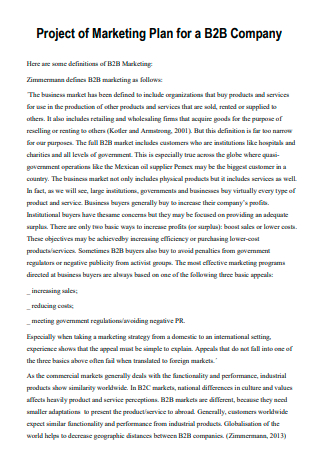
B2B Company Project of Marketing Plan
download now -
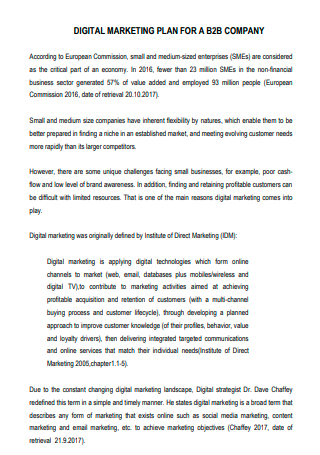
B2B Company Digital Marketing Plan
download now -
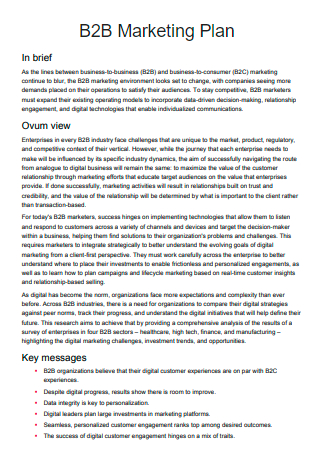
B2B Marketing Plan Example
download now -
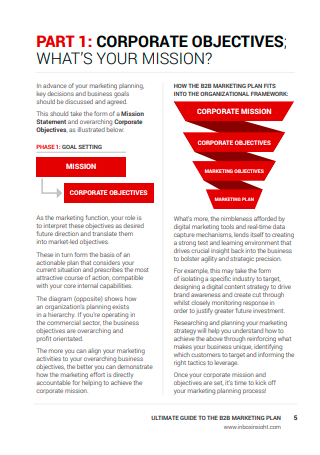
Printable B2B Marketing Plan
download now -
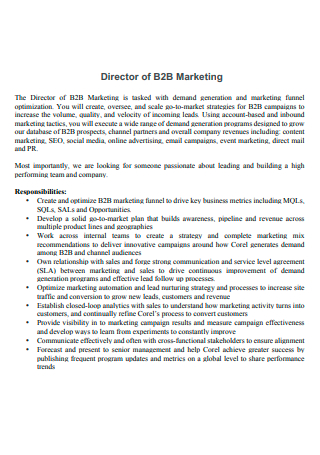
Director of B2B Marketing Plan
download now -
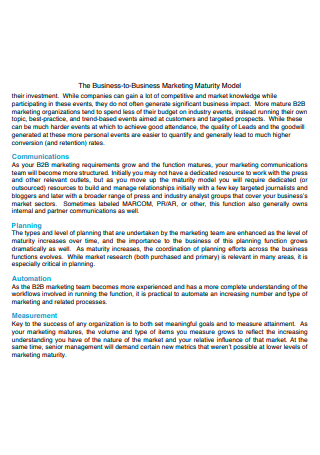
B2B Marketing Maturity Model Planning
download now -
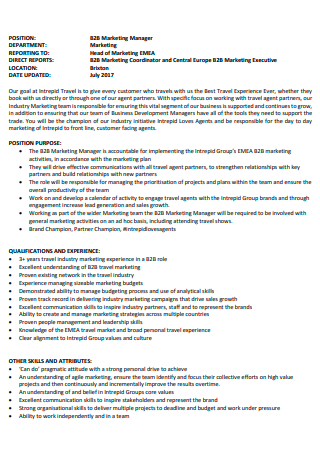
B2B Marketing Manager Plan
download now -
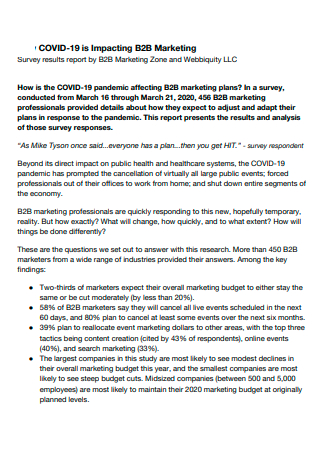
Covid -19 is Impacting B2B Marketing Plan
download now -
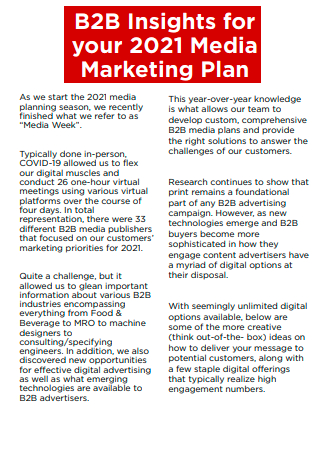
B2B Media Marketing Plan
download now
What Is a B2B Marketing?
Business-to-business marketing is a sort of marketing that targets other businesses rather than consumers. B2B sales refer to the process of selling a product or service to a company, whether it be a startup, small firm, or enterprise. Businesses may choose to focus only on B2B marketing if they offer a product or service they believe will appeal only to other companies, such as cloud-based software or printing services. Additionally, they may use B2B and B2C marketing to offer their product or service to businesses and individual consumers. Companies that sell exclusively to other firms in the B2B market are frequently referred to as B2B businesses. According to research, the total marketing budget spent on content marketing is 26% for B2B firms. The most successful B2B firms invest 40% of their overall marketing budget in content marketing, while the least successful spend 14%.
Benefits of B2B Marketing Plan
Business to business marketing is used to describe the process of marketing products or services to other companies or organizations. It’s worth noting that while discussing B2B, the goods or services are supplied to businesses, not consumers. Our customers may be organizations, companies, or individuals. They can use the product to manufacture other products, operational needs, or resale. B2B marketing is critical when it comes to determining the demands of clients before launching any adverts. Let’s look at some of the benefits of B2B marketing.
Tips on How To Do B2B Marketing
B2B marketing organizations use four critical tactics to improve lead generation and sales. The B2B marketing programs listed below have been shown to help businesses expand.
1. Research Customer Pain Points
Successful B2B marketing begins with a thorough understanding of your customers’ needs. Simply offering a product or service does not guarantee that clients will flock to you. Determine what motivates demand for your product/service and how you may differentiate yourself from the competitors. Creating client user groups is one technique to understand your customers’ needs better. Like focus groups for new products, customer user groups tap into the pool of people who already use your solutions. For instance, after interviewing your customer user group, you may discover that marketing for IT organizations is more useful when you focus on the cloud security pain issue. Identifying these pain points might help you customize your marketing message significantly. User groups might be held in person, or surveys can be developed to elicit buyers’ particular pain points before seeking your solution. Additionally, you can do keyword research to determine organic search demand or leverage current data about your sector.
2. Use B2B SEO
SEO is a critical component of your B2B internet marketing strategy. Prospects must make educated choices, so they perform preliminary internet research. If you are not the first result for the product or service you are selling, you may not be considered as a potential vendor at all. Utilizing content marketing for your business website is one strategy to boost your SEO. Content marketing enables you to establish your business as an authoritative figure in the eyes of both search engines and users. Indeed, content strategy has been shown to have a significant influence in B2B industrial marketing and site design. These factors contribute to manufacturers’ SEO and organic search traffic growth. By releasing highly informative content consistently, you demonstrate your subject matter expertise and assist consumers in making more educated decisions. You can control the search results for your products/services by integrating B2B internet marketing methods such as reviews and content marketing. Not only will business prospects find you more frequently in search results, but your thoughts will help establish your credibility as a trustworthy service.
3. Make Business Use of Social Media
Social media has shifted from being a determining factor to a qualifying factor. Having a social media presence on its own will no longer differentiate your firm from the competition. You are expected to be active and present on critical social media platforms, and your absence may disqualify you from potential clients. Business purchasing managers evaluate your organization’s suitability using social media evaluations and cultural factors. This is especially true for artistic industries, such as corporations searching for top marketing firms or professional services. There are numerous reasons why your business requires social media marketing, but simply maintaining an active presence on your channels may not be sufficient. Due to user saturation, organic reach on social media has decreased in recent years. You must have a sponsored social media budget to gain the most exposure to potential clients.
4. B2B Advertising
Your B2B internet marketing strategy should combine paid search and social media advertising. If done effectively, these paid B2B marketing services can yield a significant return on investment. Learning how to advertise effectively on social media might help you connect with your prospects where they already hang out. While the decision-makers and purchasing managers you’re addressing represent corporations, they are ultimately just people. They spend time on social media carriers, and you may contact them with the powerful targeting options available on today’s most popular social media platforms. Paid search is another effective method of attracting suitable prospects. The distinction between organic and sponsored search is that you may bypass the queue and appear externally at the top of the search results, financing significant SEO time with paid search. The paid search focuses on your prospects’ specific interests when they are interested. Traditional marketing frequently targets users based on their demographics. This is why many business to business marketing strategies place a higher premium on digital marketing than traditional marketing.
How To Create a B2B Marketing Plan
A good business-to-business marketing plan is a critical component of success in today’s highly competitive global marketplace. With digital content and properties gaining a growing share of the attention of B2B decision-makers, your business needs to establish a B2B marketing plan that covers both traditional and emergent promotional opportunities. However, developing a strategy for B2B marketing is easier said than done. With this in mind, here are several techniques for creating one.
-
Step 1 Define your target market.
The first step in producing an effective B2B marketing strategy is accurately defining your target demographic. Consider the businesses that could benefit from your product or service and jot down the specific pain problems they have. What would persuade them to purchase your wares? What would their primary concern be? What is the purpose of your call to action (CTA)? The answers to these questions should tell your marketing efforts, allowing you to adjust your marketing approaches to the buyer profiles you wish to target. Additionally, at this stage, you may want to develop a list of specific organizations that you believe would make excellent potential customers so that your sales staff can contact them directly.
-
Step 2 Determine your distribution networks.
Cold calling, inbound landing pages, Email Marketing, podcasts, social media platforms, influencer marketing, trade shows, SEO messaging, testimonials, business conferences, direct mail, webinars, and sponsorships are just some of the physical and digital marketing channels available for B2B marketing. Determine which marketing channels will be most visible to the essential stakeholders in your demographic who make purchasing choices. Depending on your business, you may want to focus exclusively on social media, important web marketing, or in-person or print marketing.
-
Step 3 Indicate the primary selling points.
Once you’ve decided who your target viewers are and how to reach them best, please choose the most effective material for them to hear. Outline your primary selling points—how will your B2B product improve sales, the customer experience, or employee morale? Be as specific as possible with numbers, Case Studies, infographics, and any other facts and details—businesses want to know that your product or service will help them grow in the long run.
-
Step 4 Develop your content.
Once you’ve settled on your message, it’s time to construct your content. Create copy and graphics that are attention-grabbing, professional, and persuasive to your audience. Consider your selected platforms and tailor your material accordingly—social media is better suited to short-form, visual content, whereas blog entries may contain more text.
-
Step 5 Implement your campaign and monitor the results.
Keep an eye on the figures as your campaign progresses. For example, which channels generate the most callbacks? What are the primary reasons for hesitancy among your prospective B2B buyers? This data enables you to fine-tune or divert your current campaign metrics and create even more effective future efforts. Your marketing effort may not immediately generate significant leads or significantly enhance conversion rates. Occasionally, an early campaign might raise brand awareness and groundwork for future successful initiatives.
FAQs
What are the four distinct forms of marketing?
Market systems are classified into four categories: perfect competition, monopolistic competition, oligopoly, and monopoly. One point to remember is that not all of these market configurations exist. Several of them are purely conceptual.
How distinct is business-to-business marketing?
B2B and B2C marketing are essentially distinguished by their target audiences and how they communicate with them. While B2C marketing focuses on providing immediate solutions and entertaining content, B2B marketing is more concerned with developing connections and demonstrating a product’s return on investment to a business customer.
What is C2C model?
Customer-to-customer (C2C) commerce is a company strategy that enables customers to transact with one another, most frequently online. C2C firms are a subset of business models that arose due to e-commerce and the sharing economy.
Planning and implementing an effective B2B marketing strategy for most brands is not an in-house capability. Your marketing team already has a lot on its plate, and by outsourcing strategy to an established B2B marketing business, you gain access to specialists with extensive industry knowledge.
